|
History and evolution of mangroves
As is usual when one enters the realms
of science one must first come to term with the terminology. Scientists
often tend to extend the mystique of their subject by divising an elaborate
set of terms. The treatment of mangroves has not been immune to this approach.
The Shorter Oxford Dictionary describe the
word "mangrove" as obscurely connected with the Portuguese word "mangue"
and the Spanish word "mangle" and the English word "grove" and it dates
its origin as 1613. Marta Vannucci in her book "The Mangrove and
Us" points out that the word is neither Portuguese nor Spanish and,
after an exhaustive search, she concludes that the word "mangue" derives
from the national language of Senegal. She comments that it was probably
adopted by the Portuguese, and later modified by the Spanish, as a result
of their exploration of the coast of West Africa.
The term "mangrove" has been applied historically
to plants which live in muddy, wet soil in tropical or subtropical tidal
waters. In the nineteen sixties the term "mangal" was used for a community
of mangrove plants and the term "mangrove" for the plant species making
up the forest. The terminology has tended to fall into disuse recently
and term such as "mangrove forest", "tidal forest" and "coastal woodland"
have begun to appear from groups of evergreen plants possessing marked
similarities in their physiological characteristics and structural adaptations
to habitats influenced by the tides. The scientific literature is divided
broadly into studies of the biology of individual species of plants or
animals in the mangroves and the study of communities that may involve
just plants or the relationship between plants and animals. The present
intention is to sketch the most important features of mangroves and mangrove
communities in such a way that they can be understood by the interested
user.
Mangroves can be trees, shrubs, palms or
ground ferns growing in the zone between high and low tide. Every kind
of plant has a Latin name or latinised scientific name and mangroves are
no exception.
The Swedish naturalist, Carl von Linne
(Linnaeus) in 1735 devised a system for classifying plants and animals
in systematic way. Linnaeus assigned each different kind of organism a
latinised double name consisting of a genus name followed by an exclusive
species name. This system is known as binomial nomenclature.
The classification of plants divides them
into various categories, based on increasing degree of similarity. The
largest categories are division, which are subdivided into classes, order,
families, and genera. Each genus may contain only a single species or many
closely related species. Biological species are physically and genetically
similar to the extent they may interbreed to produce viable offspring.
An example of the taxonomic classification
of a particular mangrove is as follows :
Division : Spermatophyta
Class : Dicotyledonae
Order : Rhizophorales
Family : Rhizophoraceae
Genus : Rhizophora
Species : stylosa
Scientific name : Rhizophora
stylosa Griff.
Common name : Spider mangrove
There are approximately 70 species of true
mangroves of which some 65 contribute significantly to the structure of
mangrove forests. Approximately 15 species occur in South-East Asia, approximately
15 species occur in Africa, and approximately 10 species occur in the America.
There are nineteen plant families with
mangrove representatives and only two families which are exclusively mangrove.
There are no order or higher ranks that are exclusively mangroves. Mangroves
are not a single genetic group but represent genetic adaptation of a large
variety of plant families to a particular environment. In case of plant
family, Rhizophoraceae, often considered to be a true mangrove family,
only four of its 16 genera inhabit a mangrove habitat.
Extensive mangrove stands require a layer
of earth or sand, usually deposited by rivers and flood tides and shores
free of strong wave and tidal action. The also require salt and brackish
water. Mangroves are often characterized by aerial roots, seedling that
germinate on the tree and buoyant seeds that can be dispersed by water.
Mangroves are often found in regions such as estuaries, embayments and
broad muddy tidal flats where the local terrain has led to the build up
of soil. They prefer sheltered places where tidal and wind are not too
destructive. The conditions in which mangroves grow also influence their
characteristics for survival, their size and the pattern in which they
congregate. On a global scale mangrove distribution is influenced by the
presence of warm and cold oceanic currents.
Mangrove shores and forest
Mangrove forests are best developed on
tropical shorelines where there are large areas available between high
and low tide points. Large mangrove formation are typically found in sheltered
muddy shorelines that are often associated with the formation of deltas
at the mouth of a river system. Mangroves can also be found growing on
sandy and rocky shores, coral reefs and oceanic islands. There are instances
where islands can be completely covered by mangroves. It is impossible
to describe a typical mangrove forest, as the variation in height and girth,
even for the same species, is immense, depending on the many factors that
control growth
All plants require various mineral elements
to survive and these are absorbed by the roots from the soil. Plants require
nitrogen, phosphorus, potassium, calcium, magnesium, sulphur and iron.
Sodium chlorides required only in trace quantities and this poses certain
problems for mangroves due to high abundance of these two elements in the
sea water surrounding their roots. Other trace elements required by the
plants for successful growth are boron, manganese, zinc, copper and molybdenum.
Mangrove soils are quite different from
those that most other terrestrial plants grow on. They are poorly drained,
lacking in oxygen and are often fine grained and rich in organic matter.
In appearance the soils are often clayey mud or sand.
Mangroves grow on waterlogged soils that
are often lacking in oxygen. These are known as anaerobic soils, literally,
soil without air. The lack of oxygen in the soil is due to the slow rate
of diffusion of oxygen in water and the biological activity of microorganisms
in the soil which consumes oxygen. The amount of oxygen in the soil varies
according to how often and for how long tides cover the mud, how well drained
the areas are, and whether there are chemicals in the soil that absorb
oxygen. Oxygen in the soil could be expected to increase in proportion
to the amount of time that the soil is exposed to the air and the soil
is covered by water. Extreme lack of oxygen in the soil can lead to the
formation of gas, hydrogen sulphide, which has rotten egg smell often associated
with mangrove swamps.
The various functional types of mangrove forest
can be briefly described as :
Over wash mangrove forests : These are
small islands covered with mangroves that are frequently washed by the
tides. The dominant species is Rhizophora mangle or the red mangrove.
Fringing mangrove forests : These strips
of mangrove found along waterways and covered by daily tides. The dominant
species is Rhizophora mangle.
Riverine mangrove forests : These are luxuriant
stands of mangrove along tidal rivers and creek with a good input of fresh
water. Often composed of Rhizophora, Avicennia.
Basin mangrove forests : These are stunted
mangroves located in places such as the interior of swamps. Often dominated
by Avicennia.
Hammock mangrove forests : Similar to basin
mangrove forests but are found in more elevated sites.
Scrub mangrove forest : A dwarfed stand
of mangroves found on flat coastal fringes.
The mangrove forest is transitional between
land and sea, the animals that live there can come from either
environment. The mangrove animals
live in a variety of habitats which can range from within or on the surface
of the mud, through the creeks,
channels and pools, to the tree roots, trunk and canopy. The tidal cycle
exercises a profound influence over
the behavior and activity of marine animals in the mangrove. Large
mangrove animals living on the surface
of the mud, which is exposed at low tides, are almost always protected
from drying out by a shell or some hard supporting structure.
Fishes, shell fishes and crustaceans
:
Major constituents of this group
in the mangrove environment of India are 105 species of fishes, 20 species
of shell fished and more than
225 species of crustaceans. Among these, commercially important are
Meretrix sp., Crassostrea sp.,
Penaeus sp., Scylla serrata and Mugil cephalis
Many crustaceans in the mangroves make
burrows which are used for refuge, the feeding, as a source of water or
for establishing a territory necessary for mating. Some may filter water
through their burrows, feeding on suspended detritus and plankton while
others may breed there. These burrows play and important role in the mangroves,
aerating, draining and turning the dense waterlogged soil - a direct benefit
to the plants which in turn give them shelter.
There is a limit to how many burrows can
be dug in any one area. It seems that when there are too many, homeless
crabs may try to take over occupied ones. Some fiddler crabs and ghost
crabs have been observed filing in the burrows of their neighbors to maintain
their territories.
Scylla serrata, the large
edible swimming crab, inhabits the muddy bottom of mangrove estuaries,
as well as
coastal brackish water. Thalassina
anomala, the mud lobster is also found along estuaries and tidal rivers.
They build long tunneling burrows
that can reach up to four meters in length and can be recognized by
spectacular turrets of earth rising
to two meters in height above the surface.
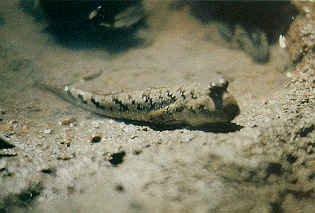
Mud skippers are one of the fish which
live on the mud flats associated with mangroves shores. The mud
skipper is a fish well adapted to alternating
period of exposure to air and submersion and is frequently seen
hopping along the mud at the water's edge. They are well-comouflaged and
able to change colour to match their background. It respires under water
like other fish but out of the water gulp air. When
submerged it swims like a fish but on land proceeds by a series of skips.
Some of them can even climb trees
using their fused pelvic (rear) fins as suckers and their pectoral fins
as grasping 'arms'. When a mud skippers is out of water it carries in its
expanded gill chamber a reserve from which to extract oxygen. After a few
minutes, when this reserve is exhausted, it is replenished from pool or
from water in the burrows which they dig. The mud skipper's most noticeable
feature is a pair of highly mobile eyes perched on top of the head to
increase the field of view and to enable it to see both under and over
the water.
Birds are a prominent part of most
mangrove forests and they are often present in large numbers. The
mangrove habitats offer rich feeding
grounds for many of the large and more spectacular species as well
as a multitude of small birds.
About 177 species of resident and migratory birds are found in the mangrove
forests. The most common among these
are Kingfishers, herons, storks, sea eagles, kites, sand pipers, Curlews,
terens etc. Flamingoes flock the exposed mud flats, during the low tides.
They use mangrove environs as breeding and feeding grounds.
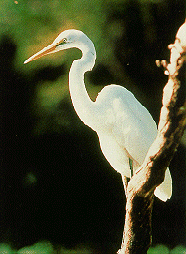 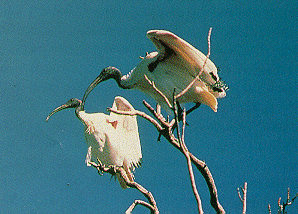 A great deal of wildlife diversity is
found in the mangrove forests of India. The Royal Bengal Tiger is one of
the unique resident species of
mangroves of the Sunderbans. Reptiles are also common in mangroves
and can include snakes, turtles, crocodiles and alligators. The salt
water crocodile, commonly found in mangroves, has adapted so well to salt
water conditions that it can survive indefinitely in a range of salinity's
and appear to have functional
salt glands on its tongue. Monitor lizard (Varanus sp.), estuarine
crocodile, various species of
monkeys, otters, deer's, fishing cats and wild pigs are some of the most
common species of mangrove forests
of India.
A great deal of wildlife diversity is
found in the mangrove forests of India. The Royal Bengal Tiger is one of
the unique resident species of
mangroves of the Sunderbans. Reptiles are also common in mangroves
and can include snakes, turtles, crocodiles and alligators. The salt
water crocodile, commonly found in mangroves, has adapted so well to salt
water conditions that it can survive indefinitely in a range of salinity's
and appear to have functional
salt glands on its tongue. Monitor lizard (Varanus sp.), estuarine
crocodile, various species of
monkeys, otters, deer's, fishing cats and wild pigs are some of the most
common species of mangrove forests
of India.
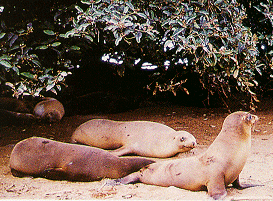 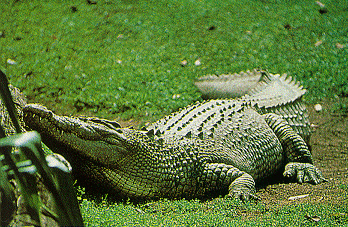 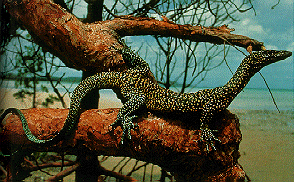 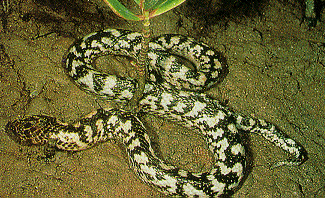
|
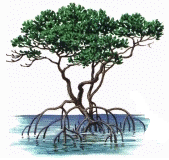 What are Mangroves
What are Mangroves